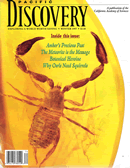|
CURRENT ISSUE
SUBSCRIBE
CONTACT US
ADVERTISING
SEARCH
BACK ISSUES
CONTRIBUTORS'
GUIDELINES
THIS WEEK IN
CALIFORNIA WILD
|
Naturalist's Almanac
What to See This Winter
Gordy Slack
January
Brown pelicans splash into the water following kamikaze-like dives from up to 30 feet above the water. The force they create stuns fish up to five feet below the surface and allows pelicans to scoop the paralyzed fish into their bills. Brown pelicans begin breeding in Mexico and on California's Channel Islands in January. But an increasing number of non-breeding pairs overwinter in northern California. One great place to watch them is Abbott's Lagoon at Point Reyes National Seashore (415) 663-1092.
Sacramento Valley is the most prominent wintering site for waterfowl, attracting more than 1.5 million ducks and 750,000 geese to seasonal marshes along the Pacific Flyway. Species include northern pintails, snow geese, tundra swans, sandhill cranes, mallards, grebes, peregrine falcons, herons, egrets, and hawks. Find spectacular birding at Gray Lodge Wildlife Area, (916) 846-3315, about two miles north of Pennington near the Sacramento National Wildlife Refuge, also great places to watch these birds(916) 934-2801.
Northern elephant seals are birthing and weaning their young through March at Ano Nuevo State Reserve, five miles south of Pescadero. Harbor seals and California and Steller sea lions can also be seen this time of year at Ano Nuevo. (415)879-0227. December through March elephant seal visits are by guided tour only. Reservations through Ticketron (800)444-PARK.
Gray whales summer in Alaska, gorging on krill. By January--when they can be seen swimming past northern California on their way to breed in Baja California--they've been fasting for months. As many as 200 grays a day may pass within a mile of Point Reyes National Seashore in the first two weeks of January. They can be seen from any high coastal bluffs along Highway One, but views from Point Lobos State Reserve, south of Carmel, and the lighthouse at Point Reyes National Seashore are especially good. For a closer (and more expensive) look from aboard a boat, call the Oceanic Society at (415)474-3385.
Anna's hummingbirds, the state's earliest
nesters, are already beginning to breed in January.
February
Some Alaskan and Canadian bald eagle populations winter in northeastern California. The Lower Klamath National Wildlife Refuge in the Klamath Basin is one good place to watch them (916)667-2231. At Cache Creek Wilderness Study Area, in Lake County, (707)462-3873, you can see both eagles wintering in the trees over the creek and endangered tule elk browsing on the hillsides nearby. Great blue herons and black-crowned night herons are nesting at Morro Bay State Park, where they share eucalyptus trees with monarch butterflies, hummingbirds, and red-shouldered hawks (805) 772-2694.
Winter is skunk mating season in California.
California sea lion numbers peak when herring
spawn in the bay. Numbers may reach 500. The best place to view them
without binoculars is from Pier 39-K dock in San Francisco. The Marine
Mammal Center operates a field station with a resident naturalist stationed
there. In March, the numbers begin to drop as the sea mammals begin
to depart for their southern breeding grounds.
March
Great winter tide-pooling at Moss Beach. Sea anenome, sea stars, nudibranchs, abalone, eels, mussel, and fish are revealed at low tides. Notice the sink line along the beach where the Seal Cove Fault fractures off of the Calaveras Fault. Birding from the beach features pelicans, cormorants, murres, willets, godwits, and others. Docent-led tide pool tours available on weekends through James Fitzgerald Marine Reserve (415)728-3584. Duxbury Reef Marine Reserve, in Bolinas, also offers rich intertidal marine life. Still on the state and federal endangered species lists, the sea otter, has made an impressive comeback in California. There are approximately 1,500 living along the central coast near Monterey. Colonies can be seen at Point Lobos State Reserve just outside of Carmel (408) 624-4909. Or rent a kayak near Moss Landing State Beach (408) 384-7695 and paddle alongside sea otters and seals in Elkhorn Slough.
The osprey, or "fish hawk," feeds almost exclusively on fish. With a black back and white underside, the osprey is best identified by large black patches around its eyes. From afar, the bird can be identified by the angled crook in its wings while in flight. Non-breeding pairs overwinter in California, concentrating on the coasts and at the salmon- and steelhead-filled heads of rivers that have yet to break their sandbars. Tomales Bay, where populations are rebounding thanks to pesticide control near local lakes and rivers, is an excellent place to watch osprey (415) 663- 1092.
Winter
Bugs
|
| Upland winter snow highlights
some insects, making them easier to find and observe. The jet-black
winter scorpion flies, winter caddisflies, and winter stoneflies
are especially easy to spot along rivers after a new snow. Wings
aren't of much use in the snow and broaden an insect's exposure
to the cold, so most of these bugs are wingless or nearly so. Other
insects, such as lacewings, may emerge to fly around on the odd
warm winter day. And spiders and carabid ground beetles can be found
on the hunt seeking out these early risers. But when the cold returns,
the insects take shelter and become quiescent again. |
Gordy Slack is Associate Editor of
California Wild.
|

Winter 1997
Vol. 50:1
|

